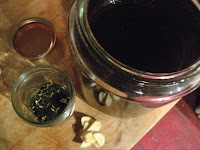
As we head out of 2008 and into the deep heart of winter, I would like to bid farewell to the beet, my vegetable obsession of the last couple months. My wine dark muse shall still take part in my wintry salads, but midnight signals a new year and the need to turn over a new leaf in our vegetable saga. What will January hold for Weird Vegetables? Hmm, dark days, new leaves--all signs point to the dark leafy green kale as the next winter vegetable of choice for this vegetable lover. How can it be that we have never posted on one of my most cherished of edible plants?
 |  |
Before you turn to your organic champagne garnished with parsley and thyme, I would like to leave you with this beet poem, commissioned from the Bay Area's itinerant market poet, Zach Houston, at the S.F. Ferry Plaza farmers' market back when I was at the height of my beet phase. When he's not trotting off to New York to participate in a gallery show or making an appearance at Art Basel in Miami Beach, you can find Zach and his Poem Store typewriter Saturdays at the Ferry Plaza and also in front of Berkeley Bowl, the champion of supermarkets. Give him a topic and he will tap out a poem for you that is sure to delight, and maybe even instruct. The poem:
If you can't quite decipher the type, the poem reads:
the blood red ukranians have foodto match their humanity and its life
blood food no reason for those two
vowels not to sound the same like
the rock and roll difference thats
between borscht and beatles black sea
and england is famous for its
music spelled wrong not song
just secretly edible roots
with two ee beatnik
misappropriated
He wrote that in about 2 minutes while following the side conversation that Erin and I were having and chiming in with a comment or two. I was impressed.




















